International Journal of Image, Graphics and Signal Processing @ijigsp
Статьи журнала - International Journal of Image, Graphics and Signal Processing
Все статьи: 1157
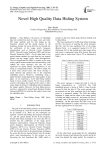
Novel High Quality Data Hiding System
Статья научная
Data Hiding is the process of embedding data into a media form such as image, voice, and video. The major methods used for data hiding are the frequency domain and the spatial domain. In the frequency domain, the secret data bits are inserted into the coefficients of the image pixel's frequency representation such as Discrete Cosine Transform (DCT) , Discrete Fourier Transform (DFT) and Discrete Wavelet Transform (DWT) . On the other hand, in the spatial domain method, the secret data bits are inserted directly into the images' pixels value decomposition. The Lest Significant Bit (LSB) is consider as the most widely spatial domain method used for data hiding. LSB embeds the secret message's bits into the least significant bit plane( Binary decomposition) of the image in a sequentially manner . The LSB is simple, but it poses some critical issues. The secret message is easily detected and attacked duo to the sequential embedding process. Moreover, embedding using a higher bit plane would degrade the image quality. In this paper, we are proposing a novel data hiding method based on Lucas number system. We use Lucas number system to decompose the images' pixels values to allow using higher bit plane for embedding without degrading the image's quality. Moreover, the data hiding process security is enhanced by using Pseudo Random Number Generators(PRNG) for selecting the image's pixels used for embedding data.
Бесплатно
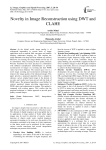
Novelty in Image Reconstruction using DWT and CLAHE
Статья научная
In the digital world, image quality is of widespread importance in several areas of image application such as medical field, aerospace and satellite imaging, underwater imaging, etc. This requires the image obtained to be sharp and clear without any artifacts. Moreover, on zooming, the image should not lose any of its information. Thus, focusing on these points, Discrete Wavelet Transform has been practiced in combination with different interpolation methodologies to provide reconstruction of images via zooming and their PSNR values have been obtained. The research gave rise to a novel image zooming and reconstruction technique that improves the image quality of the enhanced images. This paper presents a proposed algorithm that is adopted to enhance a given original input image in the domain of wavelets and results have been proved with the help of PSNR values. The proposed algorithm is used further for contrast equalized images providing improvement in PSNR values and enhancement in images. The method is compared with existing papers. This verifies that the proposed technique is a better approach to provide good quality zoomed images.
Бесплатно
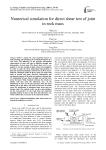
Numerical simulation for direct shear test of joint in rock mass
Статья научная
Joint is among the most important factors in understanding and estimating the mechanical behavior of a rock mass. The difference of the strength, deformation characteristic of joint will lead to different strength and deformation of rock mass. The direct shear test is very popular to test the strength of joint owing to its simplicity. In order to study the three dimensional characteristic of joint, the numerical simulation software FLAC3D is used to build the calculation model of direct shear test under both loads in normal and shear direction. Deformation and mechanical response of the joint are analyzed, showing that, (1) relationship between shear strength and normal stress meets the linear Mohr-Coulomb criterion, the results are similar with that from the laboratory test; (2) the distribution of stress on the joint increases from the shear loading side to the other; and with the increase of normal stress, the distribution of maximum shear stress does not change much. The analysis results can give some guidance for the real practice; (3) the result from the numerical modeling method is close to that from the laboratory test, which confirms the correctness of the numerical method.
Бесплатно
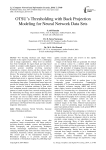
OTSU's Thresholding with Back Projection Modeling for Neural Network Data Sets
Статья научная
For Tracking interfaces and shapes which depends on the regions of pixel intensity is a challenging task in image segmentation. Many level set methods have been formulated for region based and edge based models in computer aided diagnosis systems. In order to provide accurate modeling involving numerical computations, contours, lesions and bias variance which often rely on pixel intensity variations for the region of Interest. The proposed method involves the formulation by deriving a global criterion function in terms of neighborhood pixels to represent domain field and bias variance characteristics. Gaussian impulse is used for smoothening sharp edges. Computational neural networks provide the integral part of most learning algorithms as images consists of redundant attributes of data which have redundant network connections with different input patterns of small weights form a network training process for minimizing the energy and to estimate the bias field correction for various imaging modalities. The PET and CT images are used as inputs which are affected with cancer; in order to extract the features, proposed method is used for easy diagnosis. The result shows the improved performance with Neural Networks and provides valuable diagnostic information.
Бесплатно
Object Tracking: An Experimental and Comprehensive Study on Vehicle Object in Video
Статья научная
Tracking objects on camera or video is very important for automated surveillance systems. Along with the development of techniques and scientific research in object tracking, automatic surveillance systems have gradually become better. With the input of a frame including the object to be tracked and the location information of the object to be tracked in that video. The output will be the prediction of the position of the object to be tracked on the next frame. This paper presents the comparison and experiment of some traditional object tracking methods and suggestions for improvement between them. Firstly, we examined related studies, traditional object tracking models. Secondly, we examined image and video data sets for verification purposes. Thirdly, experimenting with some related research works in traditional object tracking problems, evaluation of the existing model, what has been achieved and what has not been achieved for the current models. Propose improvements based on the combination of traditional methods. Finally, we aggregate these results to evaluate for each type of object tracking model. The results show that Particles Filter method has the highest CDT with TO score of 0.907971 on VOT dataset and 0.866259 on UAV123 dataset. However, the most stable are the two hybrid methods, the Particle filter base on Mean shift method has a TF score of 31.1 on the VOT dataset and the Kalman Filter base on Mean shift method has a TME score of 28.8233 on the UAV dataset. Because low-level features cannot represent all the information of an object to be tracked during the completion of the experiment, we can conclude that combining deep learning network and using high-level feature into the tracking model can bring better performance in the future.
Бесплатно
Object tracking via a Novel Parametric Decisions based RGB-Thermal Fusion
Статья научная
The thermo- visual fusion based tracking has been deployed for overcoming the shortcomings of alone vision-based object tracking. The assistance from both domains should be wisely merged so that it should result in a useful practice for object tracking. Several techniques had been developed recently to implement a brilliant fusion, but this undeveloped field still inhibits many unsolved challenges. The proposed method aims at increasing the effectiveness of tracking by bi-modal fusion with the introduction of a new set of rules based upon the parameters generated from the decision of individual modality trackers. This practice helps to achieve output by only a single run of the fusion process in every frame. The method also proposes to use minimal information from individual trackers in normal conditions and incorporates the use of supplementary information from imageries merely in case of diverse working conditions. This procedure, in turn, lessens the computations and hence reduces time to process. The experiments performed on well-known publically available datasets show the advantages of the proposed method over the individual visual domain tracking and other existing states of the art fusion techniques.
Бесплатно
Object tracking with a novel visual-thermal sensor fusion method in template matching
Статья научная
Recently there has been an increase in the use of thermal-visible conjunction technique in the field of surveillance applications due to complementary advantages of both. An amalgamation of these for tracking requires a reasonable scientific procedure that can efficiently make decisions with sound accuracy and excellent precision. The proposed research presents a unique idea for obtaining a robust track estimate with the thermo-visual fusion in the context of fundamental template matching. This method firstly introduces a haphazard transporting control mechanism for individual modality tracking that avoids unexpected estimates. Then it brings together an efficient computation procedure for providing the weighted output using minimal information from the individual trackers. Experiments performed on publically available datasets mark the usefulness of the proposed idea in the context of accuracy, precision and process time in comparison with the state of art methods.
Бесплатно
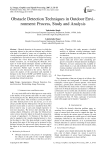
Obstacle Detection Techniques in Outdoor Environment: Process, Study and Analysis
Статья научная
Obstacle detection is the process in which the upcoming objects in the path are detected and collision with them is avoided by some sort of signalling to the visually impaired person. In this review paper we present a comprehensive and critical survey of Image Processing techniques like vision based, ground plane detection, feature extraction, etc. for detecting the obstacles. Two types of vision based techniques namely (a) Monocular vision based approach (b) Stereo Vision based approach are discussed. Further types of above described ap-proaches are also discussed in the survey. Survey dis-cusses the analysis of the associated work reported in literature in the field of SURF and SIFTS features, mo-nocular vision based approaches, texture features and ground plane obstacle detection.
Бесплатно
Occluded Human Tracking and Identification Using Image Annotation
Статья научная
The important task of human tracking can be difficult to implement in real world environment as the videos can involve complex scenes, severe occlusion and even moving background. Tracking individual objects in a cluttered scene is an important aspect of surveillance. In addition, the systems should also avoid misclassification which can lead to inaccurate tracking. This paper makes use of an efficient image annotation for human tracking. According to the literature survey, this is the first paper which proposes the application of the image annotation algorithm towards human tracking. The method divides the video scene into multiple layers assigning each layer to the individual object of interest. Since each layer has been assigned to a specific object in the video sequence: (i) we can track and analyse the movement of each object individually (ii) The method is able to reframe from misclassification as each object has been assigned a respective layer. The error incurred by the system with movement from one frame to another is presented with detailed simulations and is compared with the conventional Horn–Schunck alone.
Бесплатно
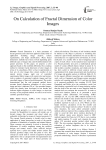
On Calculation of Fractal Dimension of Color Images
Статья научная
Fractal Dimension is a basic parameter of fractal geometry and it has been applied in many fields of application including image analysis, texture segmentation, and shape classification. Many fractal dimensions methods have been evolved depending upon different types of images that could be differentiated with greater precision. In this paper, we propose a color approach based on the modified differential box-counting method to estimate fractal dimension of color images in terms of its smoothness. Here we have experimented on four sets of color images like; sixteen number of real natural texture images, eight sets of controlled experimental fabric images with varied color and texture, twelve numbers of generated synthetic images and four smoothed images of known fractal dimension. The results demonstrated that the said proposed method shows accurate fractal dimension estimation of color texture image and also it indicates FD as 2 for smoothed images, which has already been developed in last decade and indicates higher roughness in color images, to check the accuracy of our proposed method, we used a set of twelve synthetic generated images.
Бесплатно
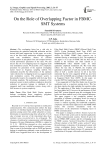
On the Role of Overlapping Factor in FBMC-SMT Systems
Статья научная
The overlapping factor has a vital role in determining the optimum bandwidth utilization and the desired side band suppression. In this paper, we review one of the filter bank multicarrier technique-staggered multi tone modulation, discuss its efficient implementation in polyphase form and compare between several performance parameters of the same. We also discuss the role of overlapping factor in staggered multi tone modulation systems. We describe a low complexity procedure for generation of the required overlapping factors based on frequency sampling method. Our simulations describe the effectiveness of the optimum value selection for overlapping factor in a staggered multi tone modulation system. The proposed system is theoretically found to be compatible with the Long Term Evolution standards. The performance evaluation of the proposed system in ideal conditions emphasizes about the reduction in spectrum leakage in sidebands of the staggered multi tone modulation system, along with a little increase in system complexity.
Бесплатно

On the Signal-Image Intensity-Curvature Content
Статья научная
The biomedical engineering problem addressed in this work is the one of finding a novel signal-image content measure called intensity-curvature functional making use of all of the second order derivatives of the model function fitted to the data. Given a signal-image made of a sequel of discrete samples and given a model function which embeds the property of second order differentiability, it is possible to quantify the content of the signal-image through a novel approach based on both of the intensity and of the total curvature of the signal-image. The signal-image is fitted with the model function. The total curvature can be calculated through the sum of all of the second order derivatives of the Hessian of the model function fitted to the data. The intensity-curvature functional is defined as the ratio between: (i) the integral of the multiplication between the value of the signal modeled through an interpolation function and the total curvature of the signal-image; both of them at the temporal-spatial location of its sampling (the grid nodes) and, (ii) the integral of the value of the multiplication between the signal modeled through an interpolation function and the total curvature of the signal-image; both of them at any given temporal-spatial location of its re-sampling (intra-pixel location). This manuscript shows both of the formulae and the qualitative results of: the intensity-curvature functional and the intensity-curvature measures which are conceptually linked to the intensity-curvature functional. The formulations here presented make the engineering innovation. The intensity-curvature functional depends on both of the model function fitting the signal-image and the magnitude of re-sampling employed to calculate the second order derivatives of the Hessian of the model function.
Бесплатно
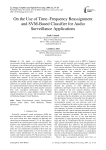
Статья научная
In this paper, we propose a robust environmental sound spectrogram classification approach. Its purpose is surveillance and security applications based on the reassignment method and log-Gabor filters. Besides, the reassignment method is applied to the spectrogram to improve the readability of the time-frequency representation, and to assure a better localization of the signal components. Our approach includes three methods. In the first two methods, the reassigned spectrograms are passed through appropriate log-Gabor filter banks and the outputs are averaged and underwent an optimal feature selection procedure based on a mutual information criterion. The third method uses the same steps but applied only to three patches extracted from each reassigned spectrogram. The proposed approach is tested on a large database consists of 1000 sounds belonging to ten classes. The recognition is based on Multiclass Support Vector Machines.
Бесплатно
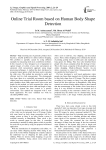
Online trial room based on human body shape detection
Статья научная
High returning rate of garments products have become a notable problem for online fashion shopping. This problem is partially caused by using different standards for measuring cloth sizes on different websites. In this research, we have designed a set of equipment to capture images of t-shirts of any color and propose an automatic cloth measurement approach using image processing techniques. A method has been introduced to recognize feature points, which has been used to calculate the cloth sizes. The method has provided a useful and efficient tool for cloth measurement. The photographs have been taken in a controlled environment, and then clothes have been categorized with the proportions of the neck, shoulder, chest width, upper waist, lower waist, and length. In this method, we have measured the t-shirt size for men by calculating the chest width and length of men. For this, a dataset has been created in a specific environment. This method has integrated with a web-based application. We have validated our work by calculating RMSE values.
Бесплатно
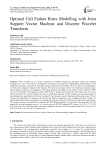
Статья научная
Failure modeling is an essential component of reliability engineering. Enhanced failure rate modeling techniques are vital to the effective development of predictive and analytical methodologies, demonstration of the engineering procedure, allocation of procedures, design, and control of procedures. However, failure rate modeling has not been given adequate treatment in the literature. The need to investigate failure rate modeling leveraging cutting-edge techniques cannot be overemphasized. This paper proposed and applied a joint support vector regression (SVR) and wavelet transform (WT) approach termed (WT-SVR) to training and learning the call failures rate in wireless system networks. The wavelet transform has been accomplished using the wavelet compression sensing technique. In this technique, the standardized call failure rate data first go through a wavelet filtering transformation matrix. This is followed by separating and outputting the transformed filtered components in the compression phase. Finally, the transformed filtered output components were trained and evaluated using the SVR based on statistical learning theory. The resultant outcome revealed that the proposed WT-SVR learning method is by far better than using only the SVR method for call rate prognostic analysis. As a case in point, the WT-SVR attained STD values of 0.12, 0.21, 2.32, 0.22, 0.90, 0.81 and 0.34 on call failure data estimation compared to the basic SVR that attained higher STD values of 0.45, 0.98, 0.99, 0.46, 1.44, 2.32 and 3.22, respectively.
Бесплатно
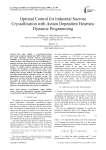
Статья научная
This paper applies a neural-network-based approximate dynamic programming (ADP) method, namely, the action dependent heuristic dynamic programming (ADHDP), to an industrial sucrose crystallization optimal control problem. The industrial sucrose crystallization is a nonlinear and slow time-varying process. It is quite difficult to establish a precise mechanism model of the crystallization, because of complex internal mechanism and interacting variables. We developed a neural network model of the crystallization based on the data from the actual sugar boiling process of sugar refinery. The ADHDP is a learningand approximation-based approach which can solve the optimization control problem of nonlinear system. The paper covers the basic principle of this learning scheme and the design of neural network controller based on the approach. The result of simulation shows the controller based on action dependent heuristic dynamic programming approach can optimize industrial sucrose crystallization.
Бесплатно

Статья научная
In this paper, the Series-Parallel (SP) and Total-Cross-Tied (T-C-T) type of conventional solar photovoltaic (SPV) array configurations or topologies are considered for modeling and comparative analysis and the parameters mainly maximum power of array, shading losses, number of interconnections or ties between array SPV modules are compared with the proposed optimal configuration under six partial shading scenarios and one un shaded case. The proposed optimal topology, optimize the number of ties required among PV modules and improves the output power of SPV array as compare to TCT configuration and also minimizes the shading power losses. These optimal interconnections are based on the location of number of shaded modules in the SPV Array. For this study, the Vikram Solar ELDORA 270 PV modules are used for modeling and simulation of SP, TCT and proposed optimal topologies in MATLAB/ Simulink software.
Бесплатно
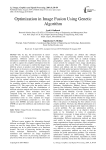
Optimization in image fusion using genetic algorithm
Статья научная
Day by day, the advancement in sensor technology is increasing which is used for image acquisition. Different sensors can acquire the information of different wavelength. These sensors are not able to capture the complete information from the scene. Thus it is necessary to combine the images from different sensors to produce more informative image. Image fusion is the process of combing the information from input images. According to the application or need, image fusion technique can be used. Number of techniques with varieties of solutions is available for image fusion process. And thus it becomes difficult task to find an optimal solution for image fusion. Genetic algorithm is an optimization technique used for searching solution for large number of complex problems [15]. This paper gives the quality index of image fusion obtained using the combinations of different selection methods and crossover techniques in genetic algorithm. These techniques have been compared using root mean square error to obtain information about relative performance. The experimental result on some standard test images shows that performance parameters i.e. root mean square error (RMSE) and peak signal to noise ratio (PSNR) are good for multifocus and multisensor image fusion.
Бесплатно
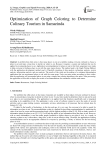
Optimization of Graph Coloring to Determine Culinary Tourism in Samarinda
Статья научная
A problem that often arises is that many places to eat are available, making everyone confused to choose a place to eat and takes a long time to decide on where to eat. Because it requires a system and methods that can be applied to recommend places to eat. Application recommendations for places to eat in this final assignment were made to help everyone in finding a place to eat with the same menu choices. The method used is the Graph Tinting Method, with the application development method used is Waterfall consisting of data analysis, technology analysis, system analysis, information analysis, and user analysis. The results of this study are the making of a restaurant determination application that can recommend places to eat with the same menu. Users can enter menus according to their wishes, then the application will recommend places to eat using a simple line coloring algorithm at the point. After processing, the application will be able to display the results of recommendations for restaurants with the same menu.
Бесплатно
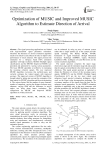
Optimization of MUSIC and Improved MUSIC Algorithm to Estimate Direction of Arrival
Статья научная
The signal processing applications are limited with high-resolution signal parameter estimation. Therefore the Direction of Arrival estimation algorithm needs to be effective and efficient in order to improve the performance of smart antennas. This paper presents the simulation for a subspace based DOA estimation algorithm with high resolution. MUSIC (Multiple signal classification) and the IMUSIC (Improved MUSIC) are presented and optimized by varying various parameters. The basic MUSIC algorithm is ineffective in estimating the incoming coherent signals. The new improved MUSIC algorithm overcomes this ineffectiveness and correctly estimates the related signals with improved accuracy. The improved version of MUSIC algorithm is brought about by taking into account the conjugate of the data matrix for MUSIC algorithm and then reconstructing it. The various factors like the number of array elements, number of snapshots, varying the distance between array elements, varying SNR and the difference in arrival angles can bring about better resolutions. The comparisons for MUSIC and Improved MUSIC algorithm are widely discussed.
Бесплатно

